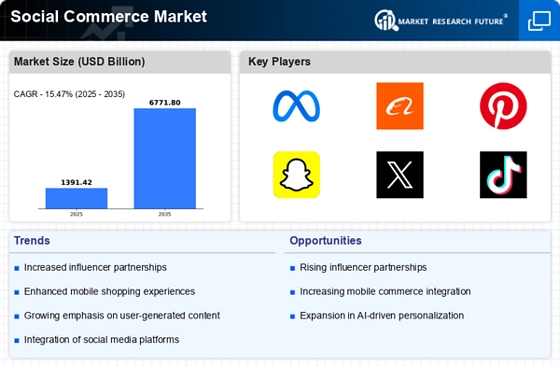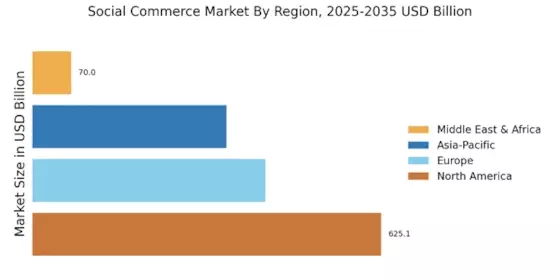Mobile Commerce Optimization
The optimization of mobile commerce is a crucial driver in the Social Commerce Market, reflecting the growing reliance on mobile devices for shopping. As of 2025, mobile commerce accounts for nearly 50% of all e-commerce sales, highlighting the necessity for businesses to enhance their mobile shopping experiences. The Social Commerce Market is adapting to this trend by prioritizing mobile-friendly interfaces, faster loading times, and streamlined checkout processes. Additionally, the integration of mobile payment solutions and augmented reality features is enhancing user engagement and satisfaction. This shift towards mobile optimization not only caters to consumer preferences but also positions brands to capture a larger share of the market. As mobile technology continues to evolve, businesses that invest in mobile commerce strategies are likely to see improved customer retention and increased sales.
Influencer Marketing Dominance
Influencer marketing continues to be a dominant force within the Social Commerce Market, shaping consumer purchasing decisions significantly. As of 2025, approximately 60% of consumers report that they have made a purchase based on an influencer's recommendation. This trend underscores the effectiveness of influencer partnerships in driving brand awareness and sales. The Social Commerce Market is characterized by a diverse range of influencers, from micro to macro, each offering unique engagement levels with their audiences. Brands are increasingly leveraging these relationships to create authentic content that resonates with consumers. Moreover, the rise of video content on platforms like Instagram and TikTok has further amplified the impact of influencer marketing, as visual storytelling enhances product appeal. This dynamic suggests that influencer collaborations will remain a critical strategy for brands aiming to thrive in the competitive landscape of social commerce.
User-Generated Content Engagement
User-generated content (UGC) is emerging as a vital driver in the Social Commerce Market, fostering authenticity and trust among consumers. As of 2025, nearly 80% of consumers indicate that they trust content created by other users more than traditional advertising. This trend highlights the importance of UGC in shaping brand perception and influencing purchasing decisions. The Social Commerce Market is witnessing brands actively encouraging customers to share their experiences and product reviews on social media platforms. This not only enhances brand visibility but also creates a sense of community among consumers. Furthermore, UGC campaigns often lead to higher engagement rates, as users are more likely to interact with content that features real-life experiences. Consequently, brands that effectively harness the power of user-generated content are likely to strengthen their market position and drive sales.
Social Media Advertising Innovations
Innovations in social media advertising are significantly influencing the Social Commerce Market, as platforms continuously evolve to enhance advertising capabilities. As of 2025, social media advertising expenditures are projected to exceed 100 billion dollars, reflecting the growing importance of targeted advertising in driving sales. The Social Commerce Market is benefiting from advanced targeting options, allowing brands to reach specific demographics and interests with precision. Additionally, the introduction of interactive ad formats, such as polls and shoppable ads, is enhancing user engagement and encouraging direct purchases. This trend suggests that businesses are increasingly recognizing the value of investing in innovative advertising strategies to capture consumer attention. As social media platforms continue to refine their advertising tools, brands that adapt to these changes are likely to achieve greater visibility and success in the competitive landscape of social commerce.
Integration of Social Media and E-commerce
The convergence of social media platforms and e-commerce functionalities is a pivotal driver in the Social Commerce Market. This integration allows users to discover and purchase products seamlessly within their favorite social media environments. As of 2025, it is estimated that over 70% of consumers utilize social media for product discovery, indicating a shift in shopping behaviors. The Social Commerce Market is witnessing a surge in platforms offering shoppable posts and live-stream shopping events, enhancing user engagement and driving sales. This trend not only facilitates impulse buying but also fosters a community-driven shopping experience, where recommendations from peers and influencers play a crucial role. Consequently, businesses are increasingly investing in social commerce strategies to capitalize on this trend, potentially leading to higher conversion rates and customer loyalty.


















Leave a Comment